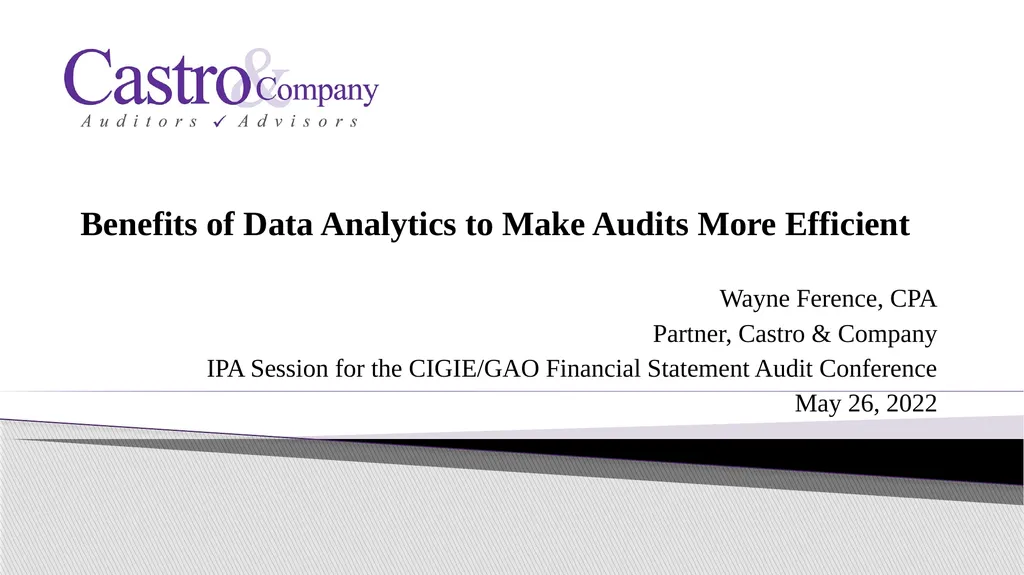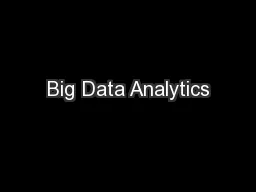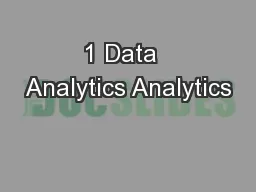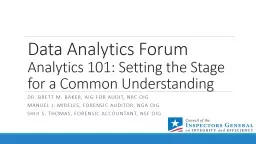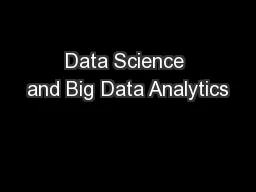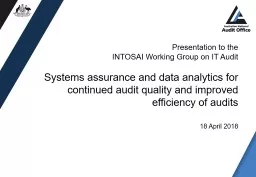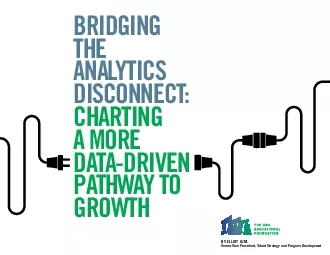Benefits of Data Analytics to Make Audits More
Author : yoshiko-marsland | Published Date : 2025-06-23
Description: Benefits of Data Analytics to Make Audits More Efficient Wayne Ference CPA Partner Castro Company IPA Session for the CIGIEGAO Financial Statement Audit Conference May 26 2022 The AICPA Center for Audit Quality has recognized data
Presentation Embed Code
Download Presentation
Download
Presentation The PPT/PDF document
"Benefits of Data Analytics to Make Audits More" is the property of its rightful owner.
Permission is granted to download and print the materials on this website for personal, non-commercial use only,
and to display it on your personal computer provided you do not modify the materials and that you retain all
copyright notices contained in the materials. By downloading content from our website, you accept the terms of
this agreement.
Transcript:Benefits of Data Analytics to Make Audits More:
Benefits of Data Analytics to Make Audits More Efficient Wayne Ference, CPA Partner, Castro & Company IPA Session for the CIGIE/GAO Financial Statement Audit Conference May 26, 2022 The AICPA Center for Audit Quality has recognized data analytics as a core capability for CPA’s and recommends using Computer Assisted Audit Techniques (CAATs) to test client data and carry out audit procedures. Here is just a few of the test scripts recommended by the AICPA: Find journal entries that do not balance Find gaps in transaction entry number sequence Find high-dollar transactions or journal entries Applying some of these tests to Federal agencies allows the auditor to: Identify financial transactions processed outside of normal USSGL posting patterns Identify disbursements in total above the funds control limit established for the agency Compare closed or voided contracts, loans, or grants to open obligations for de-obligating Compare contract or grant award amounts to accounts payable and amounts disbursed in the financial or accounting system. 2 Data Analytics to Improve Audit Efficiency Why not just use Excel or Access? 3 Training is required 2 GB database 255 fields (columns) Standard, easy to use office application Data analysis toolkit Built-in functions Built in functions Great for joining tables 1,048,576 rows by 16,384 columns 255 chars per field Microsoft Excel Analytic Capabilities Ease of use Capacity Tools Microsoft Access Requires basic training Menu based Complete set of preprogrammed analysis Unlimited Generalized Audit Software (GAS) To be done manually by user To be done manually by user Documentation Log file documents every step continuously Tool choice should depend on user expertise, data to analyze and analysis to be performed. 4 Castro & Company’s chosen data analytics tool is CaseWare’s IDEA. Using a General Ledger database of approximately 1,700 records, an intermediate-level user proficient in both Excel and IDEA, measured the amount of time required to complete these tests using both applications. Here’s what the data revealed: So, you can see that using IDEA versus Excel cuts the time to complete complex audit tests in half. What this comparison leaves out is the time required to actually design and enter the query/test parameters. In the case of Excel, this can be hours.\, and require some level of programming skill. In IDEA, these queries/test scripts are pre-programmed and just menu-driven commands that can be run instantly. Some other key comparisons: 5 Data Analytics Key Benefits IDEA stands for ‘Interactive Data
